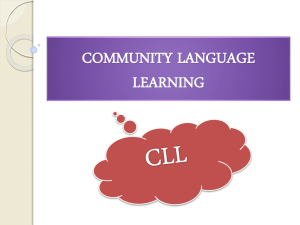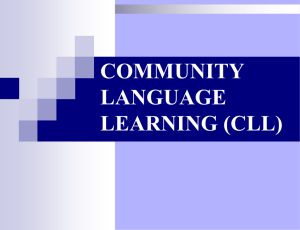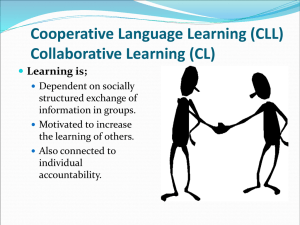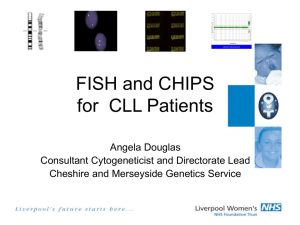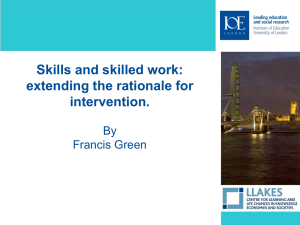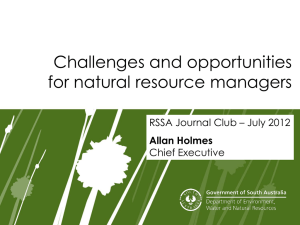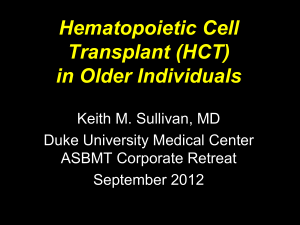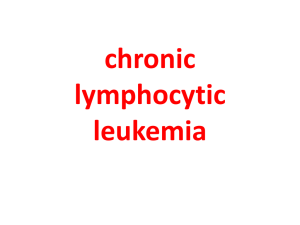The Role of Allogeneic Transplantation in High Risk CLL
advertisement
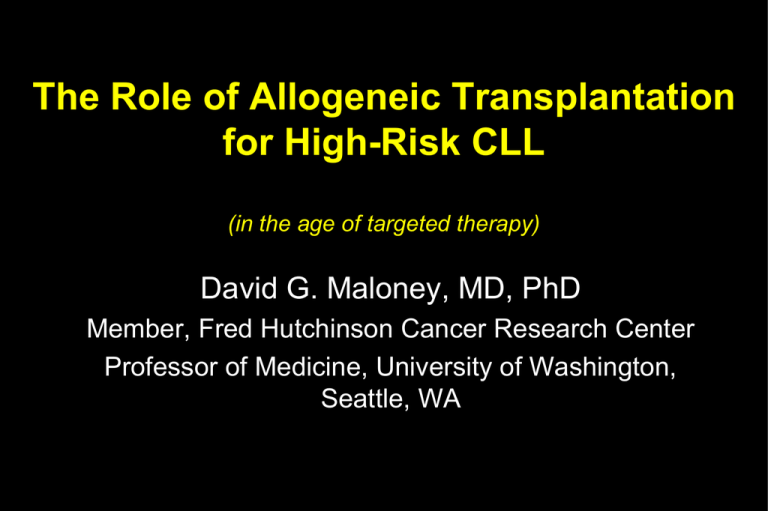
The Role of Allogeneic Transplantation for High-Risk CLL (in the age of targeted therapy) David G. Maloney, MD, PhD Member, Fred Hutchinson Cancer Research Center Professor of Medicine, University of Washington, Seattle, WA Allogeneic HCT has been Considered Standard Rx for Patients with High-Risk CLL • • • Patients refractory to purine analogues Short response to aggressive chemoimmunotherapy (FCR) < 24 mo Presence of 17p-/TP53 mutations • Early trials with myeloablative regimens have given way to reduced intensity regimens with decreased NRM • Is this still the case in the era of ibrutinib, idelalisib and ABT-199? EBMT position paper: Dreger et al, Leukemia;21; 2007, Blood, 2014 on line Survival for Fludarabine-Refractory CLL • 147 pts • Treated by different salvage therapies • Overall response rate (RR) 22% • CR 1% Keating MJ; Leu & Lym; 2002 Myeloablative Allogeneic Transplantation for CLL N Age Med(range) NRM Survival PFS Reference 54 41 (21-28) 46% @ 3y 46% @ 3y na EBMT, Michallet 1996 38 45 (26-57) 38% @ 5y 33% @ 5y 30% @ 5y CIBMTR, Pavletic 2005 25 47 (29-55) 24% @ 6y 55% @ 6y 24% @ 6y DFIC, Gribben 2005 30 48 (32-59) 47% @ 5y 39% @ 5y 39% @ 5y Canada, Toze 2005 12 39 (29-53) 25% 65% 65% Spain, Esteve 2001 28 43 (26-58) 32% @ 6y 45% @ 5y 42% @ 5y MDACC, Khouri 2002 Adapted from Delgado, Blood 2009 Adjusted Incidence Rate 0 Age 85+ 80-84 75-79 70-74 65-69 60-64 55-59 15 50-54 20 45-49 25 40-44 35-39 30-34 25-29 20-24 15-19 10-14 5-9 1-4 <1 Aging and Hematopoietic Malignancies 30 AML NHL Myeloma CLL ALL CML 10 5 Conditioning Regimens Reduced Intensity Myeloablative Cy120/TBI 12 Gy Cy200/ATG HLA-matched unrelated HLA-identical sibling Immunosuppression Genetic Disparity HLA-haploid.-related/ T-cell depleted/ Cord blood F/Cy/TBI 2 Gy Ale/F/M 140 Cy120/TBI 5.5 Gy Bu16/Cy120 F/M 180 F/TBI 2 Gy F/M 140 Bu8/F/ATG F/Cy TLI ATG Flag-Ida TBI 2 Gy TT-Cy Myelosuppression Aggressiveness of Malignancy (Adapted from R. Champlin) F/Bu16 Seattle Protocol: Nonmyeloablative Conditioning FLU 2 Gy TBI HCT Chimerism Analyses 30 mg/m2/d Days -4 -3 -2 -1 0 28 35 40 56 84 100 180 CSP/TAC BID MMF BID CSP/TAC BID MMF BID / TID McSweeney et al., Blood 97: 3390, 2001. Niederwieser et al., Blood 101: 1620, 2003. Maris et al., Blood 102: 2021, 2003. Sandmaier et al., ASH 2005, 2009. Observations using 2 Gy TBI +/- Flu • G-CSF mobilized peripheral blood source – Two days PBSC harvest – No restriction on CD34 or CD3 numbers • Out-patient treatment. – Minimal hematologic toxicity using MRD, greater with MURD • Reliable engraftment with full donor chimerism in >95% patients • Graft makes it’s own space and replaces marrow function • Anti-tumor activity due to immunologic graft-vs-tumor activity Experience with Flu/TBI for Fludarabine Refractory, Advanced CLL • 128 patients with CLL, SLL, or PLL • Transplanted between 12/1997-12/2009 • Median follow up of survivors: 64 (12-138) months Overall responses and outcomes at 5-years Percent n = 128 CR: 52% OS: 43% Relapse: 34% PFS: 36% NRM: 31% Years after HCT Outcomes by donor type (at 5-years) Overall survival Alive and on IS URD Percent MRD Years after HCT Risk factors: Disease status at HCT Refractory = 69 Responsive = 51 Progression = 8 P = 0.3 Percent Progression/relapse Years after HCT NRM Risk factors: Chromosomal abnormalities PFS Percent P = 0.22 Years after HCT del17q Normal del 11q Tri12 del 13q Others Risk factors: lymph node size ≥5 cm = 33 <5 cm = 95 PFS Percent P = 0.01 43% 14% Progression/relapse NRM P = 0.003 54% 27% Years after HCT Risk factors: OS by lymph node size < 5 cm vs > 5 cm Risk factors: Prior Alemtuzumab within 12 ms Yes = 30 No = 98 Percent PFS Progression/relapse NRM P = 0.01 Years after HCT Multivariate analyses Relapse/ Progression HR Cytogenetics LN size Disease status at HCT Prior Campath within 12 ms p PFS HR p Normal/13q 1.0 1.0 Trisomy 12 0.93 0.91 0.86 0.76 Del17q/11q/Other 1.47 0.25 1.40 0.16 < 5 cm 1.0 ≥ 5 cm 2.26 Responsive 1.0 Refractory 1.12 0.74 1.11 0.69 Progression 0.98 0.97 1.08 0.88 No 1.0 Yes 1.78 1.0 0.02 1.86 0.02 1.0 1.0 0.02 2.54 0.005 CLL: Risk-Stratification Model 3 year OS Group 1: No HCT-CI/ LN <5 cm Group 2: HCT-CI > 0 Group 3: LN > 5 cm Group 4: HCT-CI >0 and LN >5 cm 78% (n=28) 60% (n=34) 43% (n=7) 27% (n=13) Sorror JCO 2008 Selected Trials of Reduced Intensity Conditioning Allogeneic HCT for CLL Age Years (range) Regimen 82 56 (4272) 90 N Donor NRM aGVHD 2-4 cGVHD Extensive OS/PFS % Reference Flu/TBI 63% RD 37% URD 25% 5y 55% 49% RD 53% URD 50/45 5 yr Sorror et al 2008 53 (2765) Fly/Cy +/ATG 40% RD 23% 6y 45% 55% 58/38 6 yr Dreger et al 2010, 2013 76 55 (3673) Flu/Mel 33% RD 67% URD 16% 30% 62% 63/43 5 yr Brown et al 2006, 2013 40 54 (3565) Flu/TBI/R 100% RD 27% 3y 44% 29% 55/46 3 yr Michallet et al 2013 86 58 (3670) Flu/Cy/R 50% RD 17% 4y 37% 56% 51/36* 5 yr Khouri et al 2011 30 50 (12-63) Flu/Bu + ATG 50% RD 16% 2y 56% 21% 72/67 2 yr Schetelig et al 2003 Allogeneic Transplantation for CLL • Major risks are GVHD and infection – Low day 100 NRM < 5%, but 15-30% NRM at 1 year – ~25% risk of cGVHD effecting QOL • Graft vs CLL effect is active in CLL – Lower risk of relapse in the setting of cGVHD – Higher risk of relapse with T cell depletion – Clearance of MRD • May provide curative potential • Effective in high-risk disease – Fludarabine refractory – Adverse cytogenetics – unmutated Ig genes • May provides a better functioning hematopoietic and immune system post HCT Nonmyeloablative Allogeneic Transplantation for CLL • Effective therapy for fludarabine refractory CLL • Appears superior to available treatment options • Risk factors for poor outcome include – Lymph node size > 5 cm – The presence of comorbidities – Alemtuzumab within 12 months • Other factors (cytogenetics, age, CD38) did not have a significant effect on outcome • The challenge is to determine the optimal time to consider transplant – Prior to the development of bulky disease – Earlier for patients with high risk disease? B-Cell Receptor Signaling and Inhibition in B-Cell Malignancies. Stevenson F K et al. Blood 2011;118:4313-4320 Ibrutinib for Relapsed Refractory CLL Byrd J NEJM 369(1):32, 2013 Ibrutinib vs Ofatumumab for relapsed CLL (n=391) PFS Median age: Bulky disease: 17p del: Median prior Rx: FLU refractory: 67 50-60% 33% 2-3 45% PFS (6 Mo) 17p- patients OS Byrd JC et al. N Engl J Med 2014;371:213-223 Ibrutinib: Ofatumumab: 83% 49% Treatment of Refractory CLL: Idelalisib • Rituximab and Idelalisib active in relapsed/ref CLL • Improved PFS and OS compared with rituximab alone • Use in relapsed/refractory CLL warranted Furman RR et al NEJM 370(11):997, 2014 Dreger, P et al Blood Online 10/9/2014 Points to Discuss With Patients • HCT has been considered as the treatment of choice for high-risk CLL • Only documented curative potential for CLL • B cell TKI/BCL-2 inhibitors are major advances – Best option available to date – responders have 2 yr OS 70-90% (60-80% HCT) – long term uncertain, resistance possible, cure unlikely • Outcome of HCT post novel agents uncertain • HCT has early NRM (15-30%) in first 2 years with risk of cGVHD (25%) Dreger, P et al Blood Pre pub 10/2014 Conclusions: Role of Allogeneic HCT for High-Risk CLL • BCR inhibitors best available treatment – cure (or CR) seems unlikely – resistance can arise (uncertain timing) • Allogeneic HCT is still the ONLY curative option • Timing remains controversial (and patient specific) – prior to bulky disease • Randomized trials unlikely, requires close contact with HCT team • At minimum discuss options, HLA type, determine options • Targeted therapy with CAR-T cells will also impact HCT Colleagues at FHCRC / UW Mohamed Sorror Postdoctoral Fellows Transplant + Research Nurses Clinical Support Staff Collaborating Investigators • •


